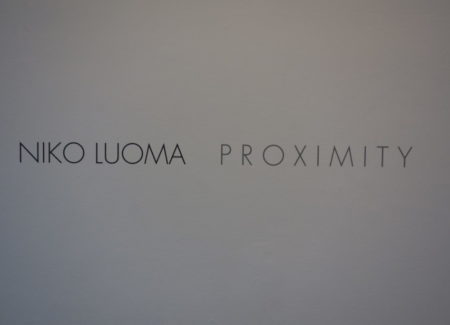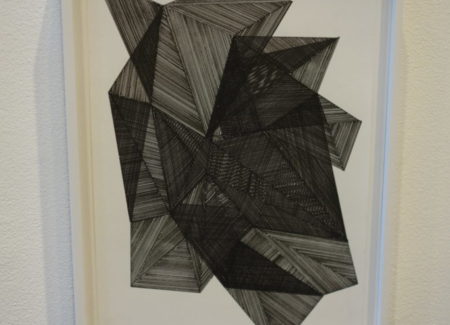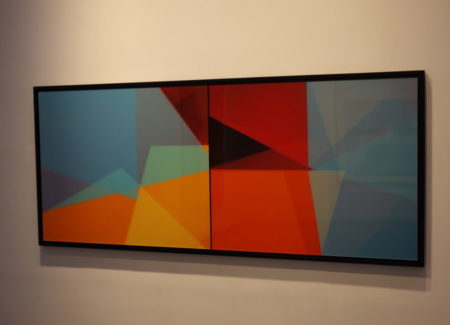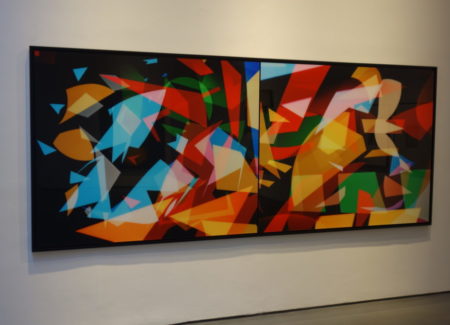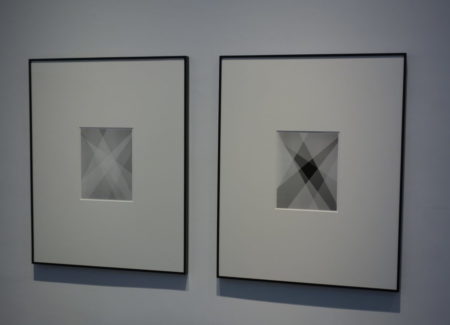JTF (just the facts): A total of 9 photographic works and 8 ink drawings, variously framed and matted, and hung against white walls in the main gallery space in back, the front room, and the connecting hallway. All of the photographs are c-prints on Diasec, made in 2017 (one is a diptych, while two others consist of two panels but are single works). Physical sizes range from roughly 14×11 to 62×153 inches (or reverse) and all of the prints are available in editions of 5 or 6. The show also includes 8 ink on paper drawings, also from 2017. Each is 12×8 and unique. (Installation shots below.)
Comments/Context: In the past decade, the Finnish photographer Niko Luoma has been busy experimenting with analog darkroom techniques, extending an artistic vocabulary built from the combination of meticulous precision and chance-driven uncertainty. He has made busy nests of thin lines, lyrical planes of additive pastels, and most recently, overlapping piles of geometric color, and in each case, he has pushed photographic abstraction in new directions.
In his newest works, Luoma takes conceptual inspiration from the time-slicing and multiple perspectives of Cubism, applying these principles of active perception to famous works from across the history of art via his own brand of formal reduction. Circling the galleries of his latest show, it would be nearly impossible for a visitor to recognize which iconic works have been the basis for Luoma’s images, and even when we are presented with pairings (via a handy cheat sheet available at the reception desk), Luoma’s interpretations often drift quite far from the original compositions. But if we then remember that Luoma’s works are bold reductions to abstraction of source images that were less than entirely representational themselves, it isn’t entirely surprising that his reinterpretations wander so freely from something we might potentially identify.
Two of the more successful works in this show take their cues from Picasso. Luoma turns the jagged elbows and fractured space of Les Demoiselles d’Avignon into a layered study in pastel pink, with the sharp angles of the geometric forms providing neutered echoes of Picasso’s brashly provocative poses. When he uses Guernica as raw material, he goes beyond the black, white, and grey of the original, rethinking the energetic bulls, horses, and crying faces in eye-popping color; and while it’s hard to follow any obvious formal parallels, Luoma’s homage does thrum with a similar brand of fragmented vitality.
Modigliani’s bodies pose more complicated problems for Luoma, and his recreations are much less engaging. While he gets the oranges, blues, and reds of the palette right in his rework of Reclining Nude, the figure has been reduced to blocky rectangles that seem to bear little resemblance to the original, except perhaps in the subtleties of mood. The same might be said for his interpretations of Standing Blonde Nude with Dropped Chemise and Caryatid; in both cases, the female silhouette has been reduced to stacked ovals, and while these shifting shapes do recall the essence of the underlying forms, the resulting images lack the understated grace notes found in the paintings.
Other works in the show draw inspiration from even wider sources. One work goes all the way back to Velázquez’ Las Meninas, and while its dense dance of colored polygons is one of the most engaging compositions in the show, the relationship to the original painting is almost indiscernible. The connections to Van Huysum’s Vase of Flowers on a Garden Ledge are much clearer; Luoma deftly uses layers of overlapped colored circles building up to additive white to replicate the wavering red and blues on the edges and the white in the middle of the original floral still life.
The inherent challenge with using famous artworks as a starting point for reinterpretations is that we are naturally led to consider how faithful the new is to the old. In these works, Luoma strays quite far from the art history textbook, allowing the vagaries of his own analog photographic techniques as well as a healthy dose of chance to influence the fidelity of the outcomes. Using representation as a guide for abstraction, he has embarked on a process of simplification and reconfiguration that finds harmony only part of the time. I almost wish Luoma hadn’t revealed the sources of his inspiration, as it might have prevented a focus on literal matches and instead encouraged a more open-ended consideration of the geometric frenzy of which he is so capable.
Collector’s POV: The photographic works in this show range in price from $10000 to $41500, based on size. The ink drawings are $4000 each. Luoma’s work is not yet consistently available in the secondary markets, so gallery retail is still likely the best option for those collectors interested in following up.
